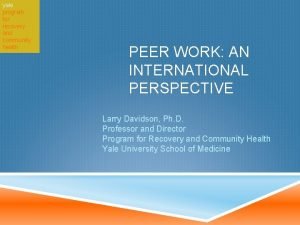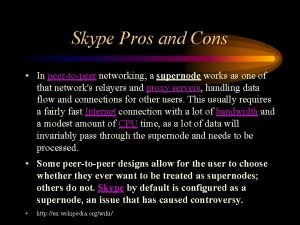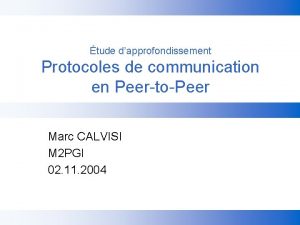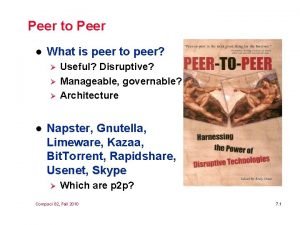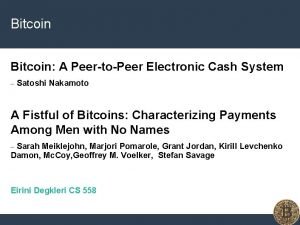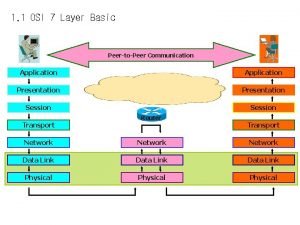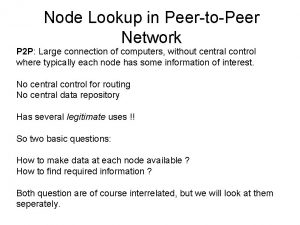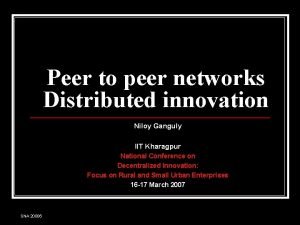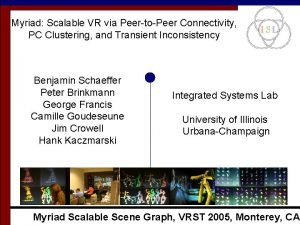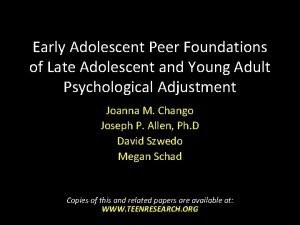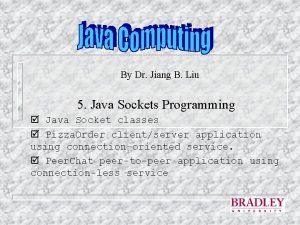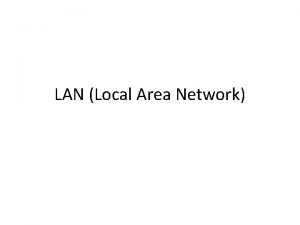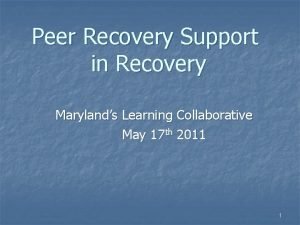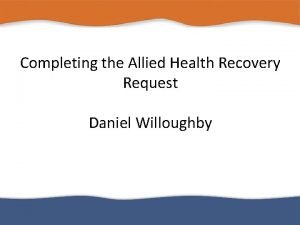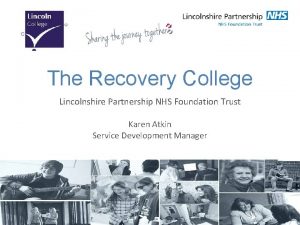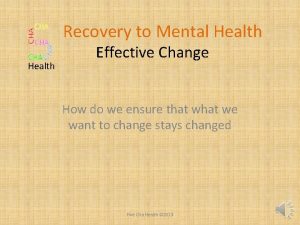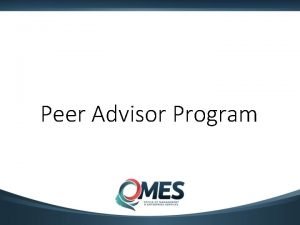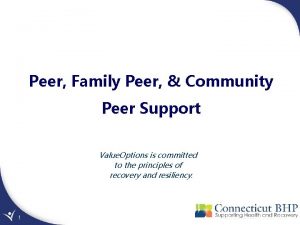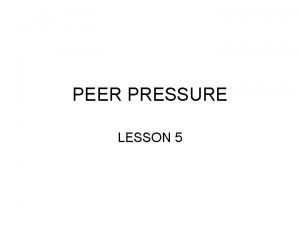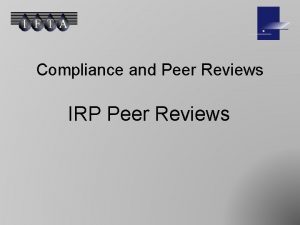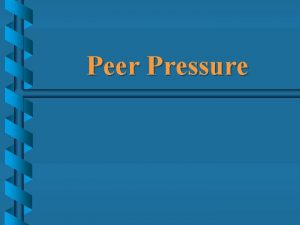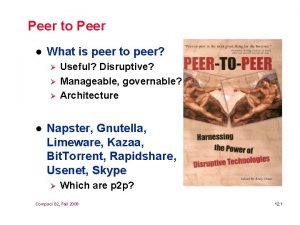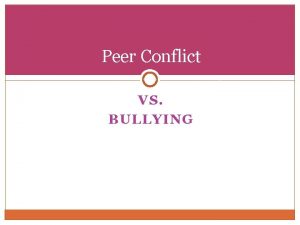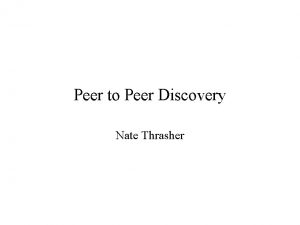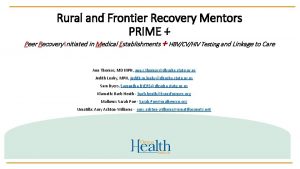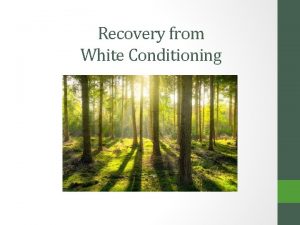yale program for recovery and community health PEER















































![“[Having] schizophrenia means you must invite me to my own party because I don’t “[Having] schizophrenia means you must invite me to my own party because I don’t](https://slidetodoc.com/presentation_image/46b26cc274a6532da5be6bb0bc682ae4/image-48.jpg)













- Slides: 61

yale program for recovery and community health PEER WORK: AN INTERNATIONAL PERSPECTIVE Larry Davidson, Ph. D. Professor and Director Program for Recovery and Community Health Yale University School of Medicine

BASIC CONSIDERATIONS Peer work is a ‘new’ profession that is undergoing rapid growth and expansion and is understood to be different things by different people There are some interesting complexities inherent to peer work of which agencies and peer workers need to be aware

BRIEF HISTORY, BUT FOR A REASON Dr. Philippe Pinel at the Salpetriere, 1795 Pussin Peer Supporter

EARLIER IN THE 20 TH CENTURY Harry Stack Sullivan People with psychosis are much more fundamentally human than otherwise Suffered from psychosis himself, and hired recovered and recovering patients to be staff

THERAPEUTIC COMMUNITIES Dominant form of institutional care in private and community hospitals from mid-century, which vestiges to this day (e. g. , level systems, community meetings) Significant role of peers in providing mutual support, role modeling, mentoring, etc. Unpaid, considered part of the person’s own treatment (similar to peer support and workordered day tasks in Clubhouses)

MAJOR INFLUENCES ON MENTAL HEALTH POLICY Dorothea Dix credited with starting state hospital movement, but wanted quality and effective care available to all in need Clifford Beers started mental hygiene movement with Adolf Meyer (today called “mental health”)

WHAT IS MY POINT? Real life (“lived”) experience provides a crucially important and valuable source of “evidence”—both of needed policy changes and of the effectiveness of peer work in promoting recovery History suggests that the lessons learned from these experiences can get separated from the experiences themselves (and the people who had them) and can be appropriated by others for various and sundry purposes

THE MORAL OF THE STORY? VIGILANCE

WHERE WE ARE NOW Contemporary peer support emerged in the 1980 s as a result of the Mental Health Consumer/Survivor/Ex-Patient Movement and quickly was taken up into addiction through development of recovery support services Peer Workers are people who have experienced mental illness and are either in or have achieved some degree of recovery. In their role as peers, they use these personal experiences of difficulties and recovery—along with relevant training and supervision—to facilitate, guide, and mentor another person’s recovery journey by instilling hope, role modeling recovery, and supporting people in their own efforts to reclaim meaningful and self-determined lives in the communities of their choice.

CONTINUUM of HEALING/HELPING RELATIONSHIPS Psychotherapy Intentional, onedirectional relationship with clinical professionals in service settings Peers as Providers of Conventional Services Intentional, one-directional relationship with peers occupying conventional case management and/or support roles in a range of service and community settings One-Directional A Intentional, voluntary, reciprocal relationship with peers in community and/or service settings Continuum of Helping Relationships Peers as Providers of Peer Support Case Management Intentional, onedirectional relationship with service providers in a range of service and community settings Self-Help/Mutual Support & Consumer. Run Programs B Intentional, one-directional (? ) relationship with peers in a range of service and community settings incorporating positive selfdisclosure, instillation of hope, role modeling, and support Reciprocal Friendship Naturally-occurring, reciprocal relationship with peers in community settings

CONSIDERATIONS Note that I am not addressing mutual support outside of the mental health system—that is not my area of expertise and I am not the person to do so. May have limited reach? Points A and B on the continuum are really different. There appears to be a lot of A going on, but little B (again, my opinion). If A wins out over time, few things will really change within the mental health system. If B, in its current form, wins out over time, some more things will change but some will stay the same. System will be enriched for sure, but perhaps not transformed. What to do about reciprocity? Can the domain of lived experience continue to be valued as a guiding spirit?

HOW CAN YOU TELL THE DIFFERENCE? Do peer staff view service users as their peers? (as seen in language, attitude, and relationships) Are peer staff encouraged to disclose their own recovery stories and to bring their life experiences with them to the table? Is there clarity in roles or does the peer staff role overlap with existing staff roles?

HOW YOU CAN TELL, PART 2 Do peer staff spend the majority of their time doing things (i. e. , solving problems) or listening? Do peer staff have a “champion” in a senior leadership position to endorse and ensure the integrity of peer work? Are peer staff viewed as one element of a broader agency- or system-wide transformation to a recovery orientation?

HOW TO TELL, PART 3 Is inevitable discrimination addressed within the work place? Is it understood to be discrimination? Are peer staff trained and supervised for the roles they are being asked to perform? Are peer staff supervised by someone who understands the value of life experience? Are there opportunities for upward mobility?

HOW TO TELL, PART 4 Is there at least a tension between … Engaging people into existing system of services and supports by encouraging attendance and adherence (e. g. , “helping people stay on their meds”) Advocating for the system itself to change in order to become more responsive to the needs of the people it serves (e. g. , peer facilitator in personcentered care planning)

EMPIRICAL EVIDENCE TO DATE First generation studies showed that it was feasible to hire people in recovery to serve as mental health staff Second generation studies showed that peer staff could generate at least equivalent outcomes to non-peer staff in similar roles; could also engage people into care and reduce readmissions Third generation studies are investigating whether or not there are unique contributions that peer support can make; these have thus far been in hope, alcohol & drug use, and activation for involvement in treatment and self-care

ENGAGE STUDY (NIDA R 01 #DA 13856) Demographics: 134 Participants Standard Care n = 44 Skills Training n = 47 Engage n = 43 66% never married 6% married 11% participants lived with someone else 83% not employed at 65% male (n = 88) 34% female (n =46) 56% African American ALL had co-occurring psychosis & substance use disorder baseline (n = 113) 32% Caucasian 14% Hispanic (n = 19)

CCCS (COLLABORATIVE AND CULTURALLY COMPETENT SERVICES) Engage participants demonstrated significantly greater improvement in CCCS scores from baseline to 9 -months than Standard Care (est. = -16. 36, p=. 04) and Skills Training (est. = -19. 04, p=. 01)

SOCIAL FUNCTIONING Engage participants have a significantly greater increase in social functioning from baseline to 9 -months than Standard Care (est. = -. 43, p =. 01) and Skills Training (est. =. 31, p=. 05)

PROBLEMS WITH ALCOHOL IN LAST 30 DAYS Engage participants demonstrated a significantly greater reduction in problems with alcohol use in the past 30 days from baseline to 3 months than Standard Care (est. = 8. 84, p<. 001) and Skills Training (est. = 7. 89, p<. 001)

TOTAL DURATION OF SERVICES DURING 1 ST AND 2 ND YEAR POST-BASELINE Engage have a significantly greater increase in time spent in services from before baseline to the first year after baseline than Standard Care (est. =-765. 26, p =. 04) and Skills Training (est. = -1183. 19, p<. 001)

Peer Engagement Study People not receiving People receiving Not engaged - Control Group Not engaged - Intervention Group peer. Linear specialists peer (Not engaged - Control Group) Linear (Notspecialists engaged - Intervention Group) 10 Level of engagement 9 8 Average Contacts Per Month Randomized, controlled trial of assertive outreach with and without peer specialist staff for people who would be considered eligible for outpatient commitment in other states. 7 6 5 4 3 2 1 0 0 1 2 3 4 Month from the Baseline Interview 5 6

CULTURALLY-RESPONSIVE PERSONCENTERED CARE FOR PSYCHOSIS (NIMH #R 01 -MH 067687) Demographics: 278 participants 143 Hispanic origin 135 African origin Conditions IMR = 84 IMR & Peer Advocate = 94 IMR & Peer Advocate = 100 and Connector Mean age 44 Average education level 11 years 15% employed 57% male (n = 88) 43% female (n =46)

6 -Month Process and Outcome Data ↓ Psychotic Symptoms but ↑ Distress from Symptoms Peer-Run Community Integration Program ↑ Satisfaction with Family Life, Positive Feelings about Self & Life, Sense of Belonging, & Social Support ↑ Engagement in Managing Illness & Use of Humor as Coping Strategy ↑ Sense of Responsiveness & Inclusion of Non-Treatment Issues in Care Planning ↓ in Spiritual Coping Peer-Facilitated Person. Centered Care Planning Illness Management & Recovery ↑ Sense of Control in Life & Power of Anger to Impact Change ↓ Satisfaction with Work Status ↓ Paranoid Ideation & Medical Problems ↑ Social Affiliation & Satisfaction with Finances ↑ Coping & Sense of Participation ↓ Sense of Activism Psychosis Medication Monitoring & Case Management African and/or Hispanic Origin Poverty

RECOVERY MENTOR STUDY n Randomized controlled design n Inpatients 18 years and older, with a diagnosis of: Schizophrenia Schizoaffective disorder Major depression Bipolar disorder n Follow up 3 and 9 months

EXPERIMENTAL CONDITION “Usual care” plus: Community-based interactions with recovery mentor as desired by participant Mentors were trained in Engaging people in trusting relationships Using positive self-disclosure to instill hope Role modeling of adaptive problem solving

DEMOGRAPHICS Characteristic Age Male Gender Experimental (n=38) Control (n=36) % or Mean (SD) P (two-tailed) 42. 37 (11. 47) 38. 69 (8. 35) . 12 17 (44. 7%) 21 (55. 3%) . 24 Race . 37 African-American 12 (32. 4%) 9 (25. 0%) Caucasian 19 (51. 4%) 24 (66. 7%) Hispanic 4 (10. 8%) 3 (8. 3%) Other/Unknown 2 (5. 4%) 0 (0%) Currently Married (yes) 8 (21. 1%) 1 (2. 8%) . 02 Number of Hospitalizations in Prior 18 months 3. 76 (1. 08) 3. 94 (1. 31) . 52 Number of Hospitalization Days in Prior 18 months 40. 0 (20. 70) 42. 31 (19. 69) . 63 Diagnosis . 92 Mood Disorder 12 (31. 6%) 11 (30. 6%) Psychotic Disorder 26 (68. 4% 25 (69. 4%

ADMISSIONS & DAYS Condition Participants Hospitalizations Mean (SD) Peer Mentor Usual Care 38 36 . 89 (1. 35) 1. 53 (1. 54) Significance: F = 2. 90, df = 1, p =. 05 (one tailed) Partial Eta Squared =. 04 Hospital Days Mean (SD) 10. 08 (17. 31) Significance: F = 3. 63, df = 1, p =. 03 (one tailed) Partial Eta Squared =. 05 19. 08 (21. 63)

ADMISSIONS & DAYS BY DIAGNOSIS Average Hospitalizations Condition Mentor Usual Care Psychotic N 26 Events. 92 (1. 41) N 24 Non-psychotic 8 . 83 (1. 27) 6 Significance: ANCOVA, p (one tailed) Events 1. 80 (1. 68). 91 (. 94) Average Days in Hospital Mentor Usual Care Condition: F = 1. 47, p =. 12 Days 11. 30 17. 39 (18. 05) (21. 41) 12. 13 10. 0 (15. 46) (20. 07) Cond. F = 1. 51, p =. 12 Partial eta squared=. 03 Dx. F = 3. 96, p =. 025 Diagnosis: F = 2. 22, p =. 07 Cond. X Dx: F = 1. 23, p =. 14 Cond. X Dx: F = 1. 28, p =. 13

SIGNIFICANT DIFFERENCES BETWEEN CONDITIONS OVER TIME FOR INTERVENING VARIABLES Condition Drug Use Hope Depressed Base- 9 Mos. line Baseline 9 Mos. Base- 9 Mos. line . 54 (1. 23) . 53 (1. 17) 39. 03 (11. 45) 38. 63 (7. 75) 4. 21 (2. 06) . 85 (1. 52) . 05 (. 21) 43. 467 (12. 52) 45. 68 (10. 59) 4. 03 (2. 28) Poor Self-Care Well-Being Base- 9 Mos. Baseline 9 Mos. 3. 20 (1. 91) 2. 04 (1. 40) 2. 80 (1. 36) 43. 56 (28. 20) 53. 65 (19. 76) 2. 64 (1. 99) 2. 09 (1. 69) 1. 68 (1. 04) 44. 70 (29. 41) 61. 40 (28. 41) Usual Care Mentor Significance p =. 004 p =. 002 p =. 016

Peer support can be considered an evidence- based practice. Practice guidelines and provider competencies are being established. Have we arrived? Is the story over?

PEER WORK HAS BEEN FOUND SO FAR TO… reduce readmissions by 42% reduce days in hospital by 48% decrease substance use decrease depression increase hopefulness increase engagement with care increase activation and self-care increase sense of well-being improve relationship with provider Recent review by Chinman et al in psych services

CURRENT SITUATION Moving away from symptom management that has (falsely) accepted long-term disability as inevitable Moving toward promoting the recovery, social inclusion, and citizenship of persons with mental heath conditions and addictions through the use of community-based supports, including peer-based support Medicine is shifting to self-management of health care conditions, including behavioral health Who better to promote self-management than peers?

WHAT DO PEOPLE NEED IN ORDER TO ENGAGE IN SELF-CARE? Available and consistent social support Accurate and accessible information (and, if needed, health education and modeling) Internal locus of control Personal sense of efficacy

FACTORS THAT MAY HAVE BEEN DETRIMENTALLY AFFECTED BY HAVING A MENTAL ILLNESS OR ADDICTION √ Availability and consistency of social support (through stigma, rejection, and alienation) √ Accurate and accessible information (and, if needed, health education and modeling) (through stigma and discrimination) √ Internal locus of control (through illness/symptoms) √ Personal sense of efficacy (through illness, repetitive failures, demoralization, and discrimination)

BEFORE THEY CAN EXERCISE SELF-CARE, THEN People may need to: Acquire or have social support Be provided with accurate and useful information about “self-care” Re-establish an internal locus of control Regain a personal sense of efficacy

THE ‘VALUE ADDED’ OF PEER WORK No matter how people may look on the outside, peer staff remember that there is still a person there on the inside Peer staff strive to connect with that person, bring out and amplify that person’s voice, make it safe for that person to come out and join in with others

FIRST, THROUGH BASIC RESPECT “Common courtesy works because it’s common; it’s something every human being gets just because they’re human. Things like saying “excuse me” when you reach over someone to reach for a piece of paper, like saying “God bless you” when someone sneezes, things like asking you if you’d like some water when you get up to get some for yourself. It’s basic, but it means so much to someone who’s been treated like an unhuman for decades. It’s basic, and it may seem trivial to you, but to people like me, it’s water to a dying parched husk of a person. Interactions like the[se] … have more positive impact on the consumer than any elaborate treatment plan ever could. ” -- Amy Johnson

REGAINING A SENSE OF BEING LOVED AND ACCEPTED … Ø Ø Ø “I’m nobody till somebody loves me. That’s the way I look at it. ” “When I was going through my psychotic changes she was always there for me. She never turned her back on me. ” “I think [riding the horse] helped me. . . It relaxed me. And, well, I guess it made me feel like the horse loved me. Spending time with the horse, it felt like unconditional love. . . you connect with the animal and with yourself and you’re outdoors and it does something to you. It’s hard to explain, but when you go home you think, ‘Wow, another lesson! Wow, I’m getting better!’”

A sense of self is the basic… Now, I have a very fleeting, very fragile sense of self. I am thwarted by visual disturbances, auditory hallucinations, tactile flashbacks, waves of intense emotion, and paranoia. I get caught up in me easily, where I literally can’t see what’s in front of me. A sense of self gives one the right to speak, it fuels the indignation required to speak… A sense of self makes all other behaviors possible; without a self, nothing can happen. This is why schizophrenia is so debilitating. Modeling self-respect and how to respect others involves active listening and improv; you must be ready at any moment to demonstrate respect. Little moments pop up … where the consumer’s weakness in self-esteem become apparent, and your job … is to pay attention to those maybe quiet holes and fill them. Self-esteem doesn’t point out where it’s been hurt, and that’s why listening is so important. You have to listen for the holes in self-esteem. Each person has a personality, and each person has a history, so the remedy for each hole may be a bit different, so you’ll have to think quickly on your feet and sort of craft a makeshift self-esteem for your client. It’s not dissimilar to a crisis triage in that you are working quickly and efficiently to save a person’s life. Self-esteem is critical to an individual’s sense of self, to an individual’s sense of efficacy, to a person’s recovery. I didn’t enter recovery until someone else thought I was worth recovery, until someone else loved me. I didn’t think I was worth recovery until someone else did. -- Amy Johnson

“You need a little love in your life and some food in your stomach before you can hold still for some damn fool’s lecture about how to behave” –Billie Holiday

REGAINING A SENSE OF PERSONAL EFFICACY Unclogging a toilet

“It is being active, and I take pride and I’m independent to a certain extent. . . like in my jazz music, like I‘ll turn on my jazz radio, and I’ll love it. . . It’s my interest. I turn the radio on myself, no one had it going to nourish themselves, to entertain themselves, like parents would at a house. I turn it on, I’m responsible, I enjoy the music, I make notes and draw while I’m hearing it. . . Then I turn it off, then I have some evidence, I’ve got something done, I’ve been productive, I have the drawings to look at. . . It was for me and by me. My own nurturing. So I’m proud of this effort. ”

“I have a good will, it just takes the right amount, the um, the kitchen has to be right, so to speak, before I do … the endeavors. The feeling has to be right. Everything has to be right before you can make a cake … If you don’t feel like buying the flour for six months … then you don’t feel like it. Then you get your flour, and then you notice you don’t have enough cinnamon, so you wait a while …”

REGAINING A SENSE OF CONTROL ”Basically, if you know recovery…it is more about taking control of your life and what you are going to do…. ”

“I'm in a contest of will with the world, with nature. . . and I say to myself: ‘Well, damn it, you just calm down and drink your coffee. ’ And I say to myself: ‘You'll just have to wait five minutes. ’ So I wait. And then the roommate's still bugging me out [but] then I have the control, the selfesteem, the confidence, and it's manageable. Then I just proudly walk to my room and take space. I mean, it's successful. ”

“there is this wicked side of me that can stop me. Just like when I’m looking for a job and see a job that would suit me, there is a voice that says, ‘Ah, that’s no job for you’, and stuff like that. And so I have to work a lot with that voice, ‘Oh, shut up, I’m going to apply for that job anyway’. It’s a struggle going on inside me all the time. ”
![Having schizophrenia means you must invite me to my own party because I dont “[Having] schizophrenia means you must invite me to my own party because I don’t](https://slidetodoc.com/presentation_image/46b26cc274a6532da5be6bb0bc682ae4/image-48.jpg)
“[Having] schizophrenia means you must invite me to my own party because I don’t know to bring myself. [You must use] nice language to describe this stranger who’s coming to the party (i. e. , me), [make her] sound like a nice person, [so that] I'd like to meet her when she arrives. ” -- Amy Johnson

I can be a friend I can ride a horse! I can make drawings I can turn on and off my own radio Scaffolding a new sense of self

ATTENTION TO MICRO-DECISIONS AND ACTS “People take for granted that you just do things. A person with mental illness, it’s sometimes hard … it’s like you’re distracted, you can’t get involved because you’re not sort of all there. ”

GETTING THERE STEP BY STEP “So I take it step by step. I have learned to hurry slowly and do it in stages and set partial goals when I have discovered that it makes sense … doing it by partial goals and making it manageable, then you get positive feedback that it’s going okay and then you don’t hit the wall. That’s my strategy, the strategy for success: partial goals and sensible goals and attainable goals, and that’s something I’ve learned to do in order to achieve things. When I have been able to deal with something that’s been a struggle and feel secure, I move on. Step by step, put things behind me. ”

“Before … everything was in the long term… Instead, having to hang on, to find strength, I live small moments more intensely. Now we’re here, you and I, and my whole life is all here, only here. It doesn’t matter what else happens… This moment here is more important than anything that might happen tomorrow. This was definitely decisive for me, this fact of living intensely what I’m doing instead of worrying about the future or other things was a real support, a cornerstone for everything … a very difficult awareness, a difficult position to take, but living intensely whatever I’m doing, being very concentrated, for me personally … I did this and no one told me to do it. I did it on my own and it works. For me. ”

“Each time I recover enough, I borrow a dog and go for a walk” “My first step after getting out of bed was to come here (to the centre); I’d come here even if it were only for 5 or 10 minutes a day. And those 5, 10 minutes turned into hours, weeks and finally I became the secretary and district representative, and now I write for Revansch! (magazine) and the local newspaper…”

IMPLICATIONS FOR PRACTICE AND CARE Most people will be able to figure out how to take care of themselves while living a meaningful and gratifying life in the face of the disorder In order to do so, they may first have to regain a sense of being loved and accepted as a worthwhile person who can have some control over his or her life and be somewhat effective in the world This may represent a first and essential step toward recovery and a first focus of efforts of peer staff to engage people in self-care

WHAT PEERS CAN DO In order to lay this essential foundation, peer staff need to pay particular attention to the microprocesses and micro-decisions of everyday life. This is because recovery is made up of the same innumerable small acts of living in which we all engage, such as walking a dog, playing with a child, sharing a meal with a friend, listening to music, or washing dishes. It is nothing more but also nothing less.

“YOU CAN DO IT. WE CAN HELP. ”* Focus on eliciting and enhancing the person’s own sense of control and efficacy, as only the person him or herself can enter into, pursue, and maintain his or her own recovery Focus on identifying and building upon each person’s assets, strengths, and areas of health and competence to support the person’s efforts to manage his or her condition while establishing or regaining a whole life and a meaningful sense of belonging in and to the community. *The Home Depot

THEN WHAT? ‘Invite’ people to take up an active role in their own care (i. e. , self-care) Explore person and family’s own understanding of the situation Provide information, education, and role modeling related to self-care Connect self-care to personally relevant goals, aspirations, and understanding

EXAMPLES People may want to: Go to school Get a job Get a boyfriend/girlfriend Open a checking account Go fishing Learn to sew, cook, or knit Challenge: How will self-care help people to participate in these activities? ? ?

RECOVERY CANNOT BE SIMPLY THE LATEST THING WE DO TO PEOPLE WITH BEHAVIORAL HEALTH CONDITIONS Recovery

IN THE END … “all they’ve got to get close to me and save me from the death of alienation, is compassion. They must be super compassionate, trying to imagine all the time what it must be like for me, and, willing to sit down with me and give me lots of their time, as we struggle to understand each other, as we map out a common language that is translatable in both my native tongue and theirs. ” -- Amy Johnson

REACTIONS, QUESTIONS … ? ? ?
 Larry davidson yale
Larry davidson yale Features of peer to peer network and client server network
Features of peer to peer network and client server network Skype for business review pros and cons
Skype for business review pros and cons Annotazioni sulla verifica effettuata peer to peer
Annotazioni sulla verifica effettuata peer to peer Peer-to-peer
Peer-to-peer Tim beamer
Tim beamer Peer to peer transactional replication
Peer to peer transactional replication Konsep dasar jaringan komputer
Konsep dasar jaringan komputer Esempio registro peer to peer compilato
Esempio registro peer to peer compilato Esempi di peer to peer compilati 2021
Esempi di peer to peer compilati 2021 Relazione finale tutor tirocinio esempio
Relazione finale tutor tirocinio esempio Peer to peer l
Peer to peer l Peer to peer merupakan jenis jaringan… *
Peer to peer merupakan jenis jaringan… * Bitcoin: a peer-to-peer electronic cash system
Bitcoin: a peer-to-peer electronic cash system Ambiti operativi da supportare
Ambiti operativi da supportare Peer-to-peer communication in osi model
Peer-to-peer communication in osi model Peer to p
Peer to p Node lookup in peer to peer network
Node lookup in peer to peer network Peer-to-peer o que é
Peer-to-peer o que é Peer to peer computing environment
Peer to peer computing environment Peer to peer intervention
Peer to peer intervention Peer-to-peer o que é
Peer-to-peer o que é Peer-to-peer o que é
Peer-to-peer o que é Peer to peer network hardware
Peer to peer network hardware Peer to peer chat application in java
Peer to peer chat application in java Jaringan peer to peer diistilahkan dengan
Jaringan peer to peer diistilahkan dengan Role and responsibility of occupational health nurse
Role and responsibility of occupational health nurse National health program related to child health
National health program related to child health Philadelphia recovery community center
Philadelphia recovery community center Transformed people transform people
Transformed people transform people Recovery community
Recovery community Residential treatment gilman
Residential treatment gilman Ahrr example
Ahrr example Recovery college lincoln
Recovery college lincoln Steps to mental health recovery
Steps to mental health recovery Data recovery affiliate program
Data recovery affiliate program Isaca business continuity
Isaca business continuity Wisconsin medicaid estate recovery
Wisconsin medicaid estate recovery Formuö
Formuö Novell typiska drag
Novell typiska drag Tack för att ni lyssnade bild
Tack för att ni lyssnade bild Ekologiskt fotavtryck
Ekologiskt fotavtryck Shingelfrisyren
Shingelfrisyren En lathund för arbete med kontinuitetshantering
En lathund för arbete med kontinuitetshantering Personalliggare bygg undantag
Personalliggare bygg undantag Personlig tidbok för yrkesförare
Personlig tidbok för yrkesförare A gastrica
A gastrica Vad är densitet
Vad är densitet Datorkunskap för nybörjare
Datorkunskap för nybörjare Stig kerman
Stig kerman Debattartikel mall
Debattartikel mall Delegerande ledarskap
Delegerande ledarskap Nyckelkompetenser för livslångt lärande
Nyckelkompetenser för livslångt lärande Påbyggnader för flakfordon
Påbyggnader för flakfordon Tryck formel
Tryck formel Offentlig förvaltning
Offentlig förvaltning Jag har nigit för nymånens skära text
Jag har nigit för nymånens skära text Presentera för publik crossboss
Presentera för publik crossboss Jiddisch
Jiddisch Kanaans land
Kanaans land Klassificeringsstruktur för kommunala verksamheter
Klassificeringsstruktur för kommunala verksamheter Epiteltyper
Epiteltyper
